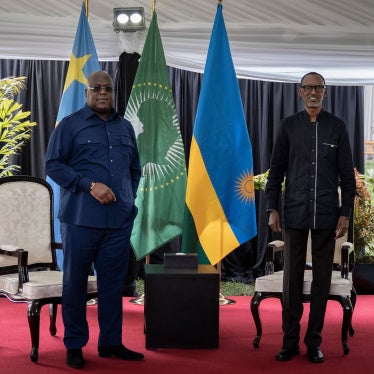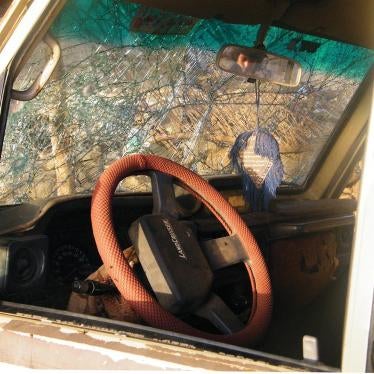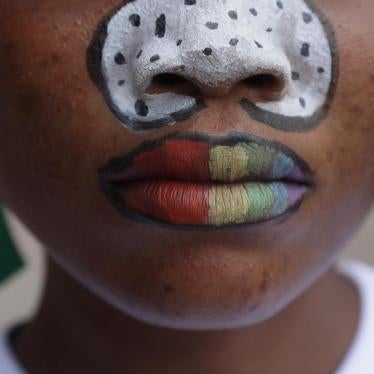(Bangui) – Armed Seleka commanders and fighters are leaving their bases in Bangui, the capital of the Central African Republic, regrouping in northeastern towns, and engaging in a new wave of horrific attacks against civilians. In some cases, Chadian peacekeeping troops have facilitated the movement of armed Seleka leaders complicit in grave abuses.
Seleka forces in January 2014 tortured and killed civilians in and around the town of Sibut, where the former rebels have been regrouping, Human Rights Watch said. Seleka forces were able to leave bases to which they had been confined by African Union peacekeepers by using bush roads to circumvent checkpoints or by traveling with Chadian troops in heavily armed convoys.
“If the African Union is truly going to protect civilians in the Central African Republic, it needs to rein in the rogue activities of the Chadian peacekeeping troops,” said Peter Bouckaert, emergencies director at Human Rights Watch. “The Chadian forces should not be enabling the Seleka to prey on civilians.”
The predominantly Muslim Seleka include numerous Chadian and Sudanese mercenaries. The African Union peacekeeping force deployed to protect civilians, known as MISCA, which officially became operational in December 2013, also includes Chadian troops. The United Nations Office of the High Commissioner for Human Rights reported in January 2014, following a December 2013 monitoring mission, that it had received “multiple testimonies of collusion” between some Chadian peacekeepers and Seleka forces.
The testimony included a report that on December 5 they went together, door-to-door, looking for members of the anti-balaka – Christian militias that have formed to respond to the Seleka, but often have targeted Muslim civilians – and indiscriminately killed at least 11 people. Those killed included elderly women and people who were ill or had mental disabilities, the report found.
Since December, MISCA, alongside the French force Sangaris, had worked to diminish the violence in the Central African Republic by containing the Seleka and their weapons at bases in Bangui. But in late January, Human Rights Watch documented movement by the Seleka on their own and in the company of Chadian troops, which coincided with a new wave of abuses.
The African Union should immediately suspend and investigate, with the support of the United Nations (UN), any Chadian MISCA troops credibly implicated in serious abuses, including assisting Seleka to carry out abuses, Human Rights Watch said.
The UN, regional organizations, and countries assisting MISCA should carefully review their support to ensure it does not benefit Chadian troops that either commit human rights violations or assist the Seleka in the commission of abuses.
“To be effective, peacekeepers should be impartial,” Bouckaert said. “The African Union should rigorously investigate whether Chadian peacekeeping forces are putting civilians at risk by supporting the Seleka.”
For details of new Seleka abuses, Chadian peacekeeper involvement, and background on the conflict, please see below.
Seleka Killings, Torture in the Sibut Area
On January 16, 2014, Seleka and anti-balaka fighters tried to hold a reconciliation meeting under the sponsorship of local authorities and religious leaders. Although Seleka fighters had given assurances that they would not harm the unarmed anti-balaka leaders, they executed all three of the anti-balaka representatives who attended the meeting, and then attacked the people who had come to watch the meeting, killing at least 16 more people. The Seleka fighters refused to allow local Red Cross volunteers to approach the area to bury the bodies, the last six of which were recovered on January 21.
A local official told Human Rights Watch:
They killed the three anti-balaka representatives at the meeting. They executed them and fired on everyone. They killed so many people. In addition to the three anti-balaka representatives, there were 16 dead who were buried by their families. But there were six bodies close to their base so we couldn’t go recover those until January 21. They consider everyone in Sibut to be anti-balaka.
Seleka fighters frequently fired at civilians they encountered in Sibut. On January 23 at 9 a.m., Seleka fighters shot at three men who were crossing the main bridge in town. The Seleka killed two of the men and gravely wounded 18-year-old Leono Wambiti, shattering his jaw and leg. The Seleka fighters remained in the area until 3 p.m. and left Wambiti bleeding on the bridge. When local villagers finally managed to help him, six hours after he was shot, they evacuated him to the bush, where he hid for nine days without medical treatment. He died from infected wounds on February 2, the day Seleka fighters left Sibut.
On January 28, a group of eight Seleka fighters detained 21-year-old Abraham Ngieri and two other young men, Michel Ngodji, 31, and Franku Mois, 24, in Sibut and took them to the main Seleka base, at the mayor’s office in Sibut. In front of the gathered Seleka commanders, the fighters tied up the three men, tortured them, and stabbed them with knives over a five-hour period, in an effort to make them reveal the location of anti-balaka bases in the area. When it became clear that the men did not know the location of the bases, the Seleka commander of Sibut, General Rakis, ordered his soldiers to take the three men away and kill them.
Ngieri, who, despite being seriously wounded, survived this attack, told Human Rights Watch:
The zone commander himself gave the order to take us away and kill us. About nine of them took us in a 4x4 blue pickup. We were still tied up, in the arbatasher way [with arms and legs tied behind the back], and they took us to a house a few kilometers from town. Then they stabbed us again, and put the house on fire over our heads. I only managed to escape because the ropes burned and I was able to free myself, but the others burned to death.
On January 29, Seleka fighters on patrol in the Isolé district of Sibut went from home to home searching for men to abduct. They entered the house of Arsène Datunu, 30, who was looking after his four children while his wife was at the market, and took him and his brother Gongéré Datunu from the house, as well as a third man from the area. They took the three men, tied them in the arbatasher style, and took them to a village five kilometers north of Sibut, where they executed the men, leaving their bodies behind.
Seleka Atrocities on the Bangui-Sibut Road
In late January, an estimated 500 armed Seleka fighters and commanders left Camp Kassai in Bangui on foot. They abducted civilians in the area and forced them to carry Seleka munitions and luggage. As they made their way north, the fighters attacked civilians in villages by the road.
On the night of January 29, Seleka fighters arrived in the village of Pata, 60 kilometers north of Bangui. They captured nine men in the village and took them to the main road. The fighters executed four of the men on the main road and then left with the other five. The next day, villagers at Vangué, about 50 kilometers from Pata, found the executed bodies of the five other men in a banana grove, right next to where a Seleka truck had broken down a week earlier. Anti-balaka forces had looted the truck. The Seleka appeared to have committed the killings in retaliation for the looting.
On February 1, the Seleka column passed near Damara, 80 miles north of Bangui, and engaged in heavy fire exchanges with local anti-balaka fighters. During this incident, some of the civilians who had been abducted were able to escape.
One man, 50, a cook at a popular Bangui restaurant, and his son, 24, were among those abducted by the Seleka leaving Bangui. They described to Human Rights Watch near Damara how they and others had been forced to carry heavy loads of munitions and luggage for the Seleka fighters. On the sixth day, the Seleka fighters summarily executed two of the other abducted civilians who were too exhausted to continue to carry their loads.
“They were shot together,” the man told Human Rights Watch: “They sat down because they had become too exhausted. The fighters ordered them to get up and they couldn’t anymore, so they just shot them.” On February 1, at the village of Ngupe, the Seleka shot dead four people in the community who were trying to flee, according to the two witnesses.
Chadian Troops Assist Seleka Leaders
On January 26, at 4:30 p.m., Human Rights Watch researchers witnessed and filmed a heavily armed convoy of Chadian peacekeeping troops about 60 kilometers north of Bangui. The convoy included at least eight pick-up trucks carrying Seleka fighters including some leaders, such as General Mahamat Bahr, the head of military intelligence for the Seleka, whom Human Rights Watch had met the day before he fled.
On January 31, General Bahr contacted Human Rights Watch by phone to say that he had traveled with the Chadian peacekeeping convoy to Bossangoa, a key town in the country’s northwest. The Chadians were to relieve peacekeeping troops from the Republic of Congo who had been stationed in Bossangoa for months. Upon taking over peacekeeping responsibilities in Bossangoa, the Chadian troops allowed another Seleka leader, Colonel Saleh Zabadi, to leave with his troops from their base, where they were ordered to remain, and to go with General Bahr and other Seleka commanders to the northern cities of Sibut, Kaga Bandoro, and Kabo, where Seleka leaders were regrouping with their forces.
In a December 2013 report, “They Came to Kill,” Human Rights Watch documented how Colonel Zabadi, then the Bossangoa deputy commander, ordered the drowning on November 18 of seven farmers who were wrongfully accused of being anti-balaka militiamen. The farmers were bound and thrown into the Ouham River; three survived. Human Rights Watch met with Zabadi and Bahr in December to confront them with the evidence and warn them they could be held criminally responsible for such crimes.
MISCA, which has a mandate to protect civilians, has worked to stabilize the Central African Republic by ordering Seleka fighters to remain on their bases and by trying to prohibit them from circulating with weapons. An official with the peacekeeping force told Human Rights Watch that the Chadians were operating outside of its command and mandate by providing escorts to armed Seleka leaders.
Background on the Conflict
The mostly Muslim Seleka forces, who seized power in March 2013, have been responsible for massive human rights abuses documented by Human Rights Watch, including massacres, rapes, executions, torture, and the burning of hundreds of villages. As a direct result of the Seleka’s widespread abuses, nearly a fifth of the country’s people have fled their homes, living in dire humanitarian conditions in the bush or camps for displaced persons.
In September, the mostly Christian anti-balaka militias began fighting back, and over the past two months have intensified revenge attacks on Muslim communities, with massacres, executions, torture, and the widespread burning and looting of Muslim homes, plunging the country deeper into bloodshed. Fearing these atrocities, Muslim residents have fled numerous northwestern towns, such as Bossangoa and Bouca, where there was once a significant and longstanding Muslim presence.
In January 2014, Michel Djotodia, the former Seleka leader appointed president in August 2013, stepped down from power at a summit in Ndjamena, Chad, where the transitional national council for the Central African Republic met to begin the process of choosing a new interim president. Catherine Samba-Panza, the former mayor of Bangui, was sworn in on January 23, 2014. She inherits a very weak government, humanitarian crisis, and ongoing conflict with regional implications.








